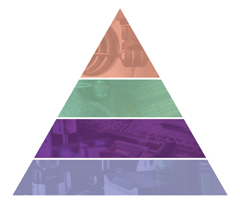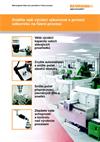Nastavení procesu
Automatické seřízení nástrojů a ustavení obrobku s využitím sond může být až 10x rychlejší než manuální metody.
Opatření v druhé vrstvě Productive Process Pyramid™ (Pyramida produktivního procesu) definují vztahy mezi strojem, nástrojem a obrobkem před zahájením obrábění. Tato automatizovaná, prediktivní opatření zajišťují správné obrobení hned první třísky.
Zajistěte správné a přesné obrábění hned od první třísky

Vrstva nastavení procesu v pyramidě se zaměřuje na zdroje proměnlivosti, jako jsou umístění součásti, velikost nástrojů a korekce na stroji, a směřuje činnosti obrábění do skutečného umístění součásti.
Jedná se o prediktivní opatření prováděná před začátkem obrábění.
Měření nástroje stanoví
- délku nástroje od čela vřetene, určení délkové korekce a ověření, že délka nástroje je v zadaných tolerancích.
- Zjištění průměru rotujícího nástroje a zavedení radiální korekce velikosti nástroje.
Měření obrobku stanoví
- identifikaci dílce a výběr správného NC programu.
- Stanovení polohy výchozího prvku na dílci a přenesení pracovního souřadného systému (WCS) do tohoto bodu.
- Stanovení velikosti přídavku na obrábění polotovaru a určení hloubky první třísky.
- Zjištění polohy obrobku vůči osám stroje a natočení WCS podle obrobku.
Měření stroje stanoví
- vyrovnání rotačních os a polohovacích a upínacích přípravků.
- Určení polohy středu otáčení indexovacího zařízení a stanovení polohy referenčních bodů na upínacích prvcích.
Prediktivní řízení
Díky automatickému nastavení pomocí sond ušetříte čas, který můžete věnovat obrábění. Ustavování pomocí sond je až desetkrát rychlejší než manuální metody.
Můžete pak lépe plánovat výrobu, protože budete vědět, jak dlouho bude nastavení trvat.
Procesy ustavení obrobku a seřízení nástrojů mohou být plně ovládány programem. Pro měření, výpočet odchylek a zavedení korekcí do nástrojových tabulek není zapotřebí činnost operátora stroje.
Obrobkové a nástrojové sondy Renishaw a software Productivity+™ jsou důležitými nástroji pro rychlé, automatické a opakovatelné nastavení obráběcích operací.
Dokumenty
-
 Brožura: Metrologická řešení pro produktivní řízení procesů
Brožura: Metrologická řešení pro produktivní řízení procesů
Změňte vaši výrobní výkonnost s pomocí odborníků na řízení procesů
